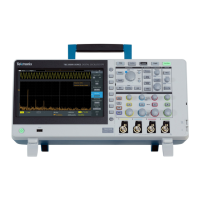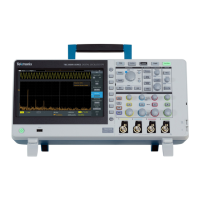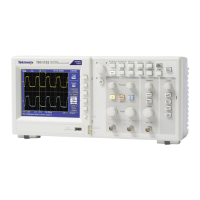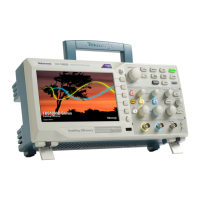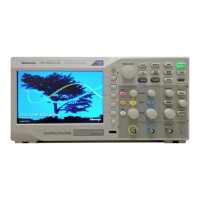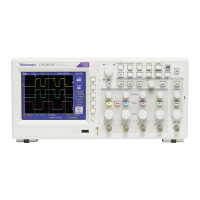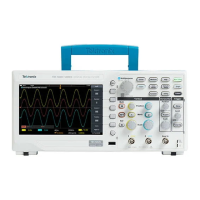
Do you have a question about the Tektronix TBS2202B and is the answer not in the manual?
| Brand | Tektronix |
|---|---|
| Model | TBS2202B |
| Category | Test Equipment |
| Language | English |
Unpack the oscilloscope and check that all items listed as standard accessories were received.
Instructions for installing field-installable license files that add features to your oscilloscope.
Overview of the oscilloscope's capabilities, including bandwidth, display, sampling, and measurement features.
Explanation of icons and symbols used throughout the manual for clarity.
Specifies the operating temperature, humidity, and altitude for the instrument's safe operation.
Details the necessary power source voltage, frequency, and consumption for the oscilloscope.
Step-by-step guide on how to correctly turn the oscilloscope on and off.
Procedure to select from 11 languages for the oscilloscope's on-screen display, readouts, and menus.
Instructions on how to connect BNC and TekVPI probes to the oscilloscope for waveform display.
Explains the process of measuring input signal amplitude and storing values to create waveform records.
Describes how the oscilloscope uses sampled data points to create and display waveforms.
Explains how the oscilloscope detects and synchronizes waveform acquisition using trigger conditions.
Details how slope and threshold level conditions are used for triggering a stable waveform.
Lists and describes various signal conditions the oscilloscope can trigger on, like Edge, Pulse Width, Runt.
Configures how input signals are passed to the oscilloscope sampling circuit (DC or AC coupling).
Adjusts the maximum frequency the oscilloscope can accurately display and measure.
Adjusts the probe's signal amplitude reduction or amplification before sending it to the input.
Adjusts the waveform's vertical position relative to the oscilloscope ground (0 volts) reference.
Compensates for signal delays between channels for accurate time-related measurements.
Sets the oscilloscope to trigger on the rising or falling edge of a waveform.
Triggers based on a pulse being less than, greater than, or equal to a specified time period.
Configures how the oscilloscope behaves in the presence or absence of a trigger.
Quickly acquires and displays a waveform by automatically setting controls.
Determines the number of sample points added to a waveform record.
Resets current settings to factory-defined defaults for a known state.
Procedure to turn the display of each channel's waveform on or off.
Adjusts how long sampled waveform points are retained and displayed on screen.
Plots signal amplitude of one channel against another for phase/frequency relationships.
Quickly takes common measurements like frequency, period, rise/fall times.
Uses on-screen lines to position and measure time/amplitude values.
Combines two channel waveforms using math operations (add, subtract, multiply).
Analyzes frequency components of a signal using Fast Fourier Transformation.
Magnifies and examines portions of waveforms with long record lengths.
Marks locations of interest and jumps between them for analysis.
Disables the Autoset function, typically requiring a password.
Disables the cursor function, typically requiring a password.
Disables measurement functions, typically requiring a password.
Saves a picture of the oscilloscope screen to a file on a USB drive.
Saves waveform data to reference memory or an external file.
Saves oscilloscope settings (vertical, horizontal, trigger, etc.) to memory or a file.
Provides a quick, one-push method to save specified data files to a USB drive.
Loads oscilloscope settings from memory or a file to configure the instrument.
Loads waveform data from an external .ISF file into reference memory.
Introduces the interface for managing files and folders on a USB drive.
Step-by-step guide to creating new folders on a connected USB drive.
Procedure to remove files or folders from a USB drive.
Removes file and directory names, making drive memory available for new files.
Selects which device (e.g., PC) is connected to the USB Device port.
Disconnects rear-panel USB Device port access to prevent remote access.
Shows the oscilloscope's IP address and related network settings.
Enables DHCP to automatically obtain an IP address from the network server.
Manually enters IP address and network settings for non-DHCP networks.
Enables or disables the Wi-Fi function to communicate wirelessly with the oscilloscope.
Displays IP address, Wi-Fi SSID, and signal level information.
Manually enters IP address and network settings for Wi-Fi in non-DHCP networks.
Enables DHCP to obtain an IP address from the network server for Wi-Fi.
Sets up and uses a socket server for two-way communication over a network.
Accesses oscilloscope controls and status via a web browser.
Steps to update the oscilloscope's operating software for new features or fixes.
Tests instrument functional modules to verify operation.
Provides guided lab exercises and learning content directly on the oscilloscope.
Buttons and knobs for controlling waveforms, cursors, and data input.
Adjusts trigger point location and horizontal scale settings.
Sets when the oscilloscope acquires signal data for waveform creation.
Adjusts vertical settings like position and scale for each channel.
Accesses menus for measurements, saving/recalling data, and system configuration.
Information regarding the environmental impact and recycling of the product.


